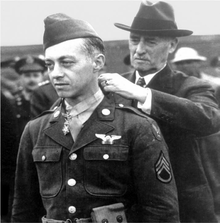Maynard Harrison SmithFrom Wikipedia, the free encyclopedia
|
Maynard Harrison Smith
|
|
|---|---|

Secretary of War Henry L. Stimson awarding the Medal of Honor to S/Sgt. Smith
|
|
| Nickname(s) | Snuffy Smith |
| Born | May 19, 1911 Caro, Michigan |
| Died | May 11, 1984 (aged 72) Saint Petersburg, Pinellas County, Florida, USA |
| Place of burial |
Arlington National Cemetery, Arlington County, Virginia, USA
|
| Allegiance | |
| Service/ |
|
| Years of service | 1942–1945 |
| Rank | |
| Unit | 423d Bombardment Squadron |
| Battles/wars | World War II |
| Awards | |
Maynard Harrison “Snuffy” Smith (May 19, 1911 – May 11, 1984) was a United States Army Air Forces Staff Sergeant and aerial gunner aboard a B-17 Flying Fortress bomber in World War II, received the Medal of Honor for his conduct during a bombing mission over France on May 1, 1943.[1][2]
Contents
Enlistment[edit]
Maynard H. Smith enlisted in the US Army Air Forces in 1942. After completing basic training he volunteered for aerial gunnery school. At the time all aerial gunners were non-commissioned officers and the move to the school was a quick way for the private to gain rank and pay.[2][3]
After completing the aerial gunnery school, he was shipped overseas to Thurleigh, Bedfordshire, in south-central England, where he joined the 423rd Bombardment Squadron, 306th Bomb Group. Staff Sergeant Smith quickly gained a reputation as a stubborn and obnoxious airman who did not get along well with the other airmen stationed there, hence his nickname “Snuffy Smith”, possibly from the popular comic strip of the era, Barney Google and Snuffy Smith. Consequently, it was six weeks before he was assigned his first combat mission.[2][3]
Medal of Honor action[edit]
It was during his first mission, on May 1, 1943 that Staff Sergeant Smith, who was assigned to the ball gun turret, helped save the lives of six of his wounded comrades, put out a blazing fire, and drove off wave after wave of German fighters.
The target of the mission was the U-Boat pens at Saint-Nazaire in Loire-Atlantique, France, on the Bay of Biscay. Saint Nazaire was heavily defended by antiaircraft guns and was nicknamed “flak city” by the airmen.[4]
Several of the bombers failed to rendezvous as intended, and others had mechanical problems and had to turn back. The middle portion of the bombing mission went well, with no German fighters engaging the mission until after they had released their bomb loads. The bombers managed to drop their payload on target with little resistance from the Germans in occupied France. As the fighters came up, the bombing group managed to elude them by flying into a large cloud bank.[4]
Due to a navigational error, after being in the cloud bank, the navigator in the lead plane believed he was approaching the southern coast of Britain. In fact, the aircraft were approaching the heavily fortified German-occupied city of Brest, France and the southern coast of the Breton Peninsula. The pilot began to descend to 2,000 feet and was almost immediately overtaken by several German fighters and intense anti-aircraft fire.[5]
Staff Sergeant Smith’s bomber was hit, rupturing the fuel tanks and igniting a massive fire in the center of the fuselage. The damage to the aircraft was severe, knocking out communications and compromising the fuselage’s integrity. Smith’s ball turret lost power and he scrambled out to assist the other crew members. Three crew members bailed out, while Smith tended to two others who were seriously wounded.
In between helping his wounded comrades, Smith also manned the .50 caliber machine guns and fought the raging fire. The heat from the fire was so intense that it had begun to melt the metal in the fuselage, threatening to break the plane in half.
For nearly 90 minutes, Smith alternated between shooting at the attacking fighters, tending to his wounded crew members and fighting the fire. To starve the fire of fuel, he threw burning debris and exploding ammunition through the large holes that the fire had melted in the fuselage. After the fire extinguishers were exhausted, Smith finally managed to put the fire out, in part by urinating on it.
Staff Sergeant Smith’s bomber reached England and landed at the first available airfield, where it broke in half as it touched down. Smith’s bomber had been hit with more than 3,500 bullets and pieces of shrapnel.
The three crew members who bailed out were never recovered and presumed lost at sea, but Smith’s efforts on that day undoubtedly saved the lives of six others aboard his aircraft.[3]
Journalist Andy Rooney, at the time a reporter for Stars and Stripes, was at the base where Smith’s plane landed and wrote a front-page story about it. While reflecting on Smith’s award years later on 60 Minutes, Rooney indicated “I was proud of my part in that.”[6]
Smith was assigned to KP duty the week that he was awarded the Medal of Honor as punishment for arriving late to a briefing. Secretary of War Henry L. Stimson placed the medal around Smith’s neck during a formation.

